
Arizona Weather Safety
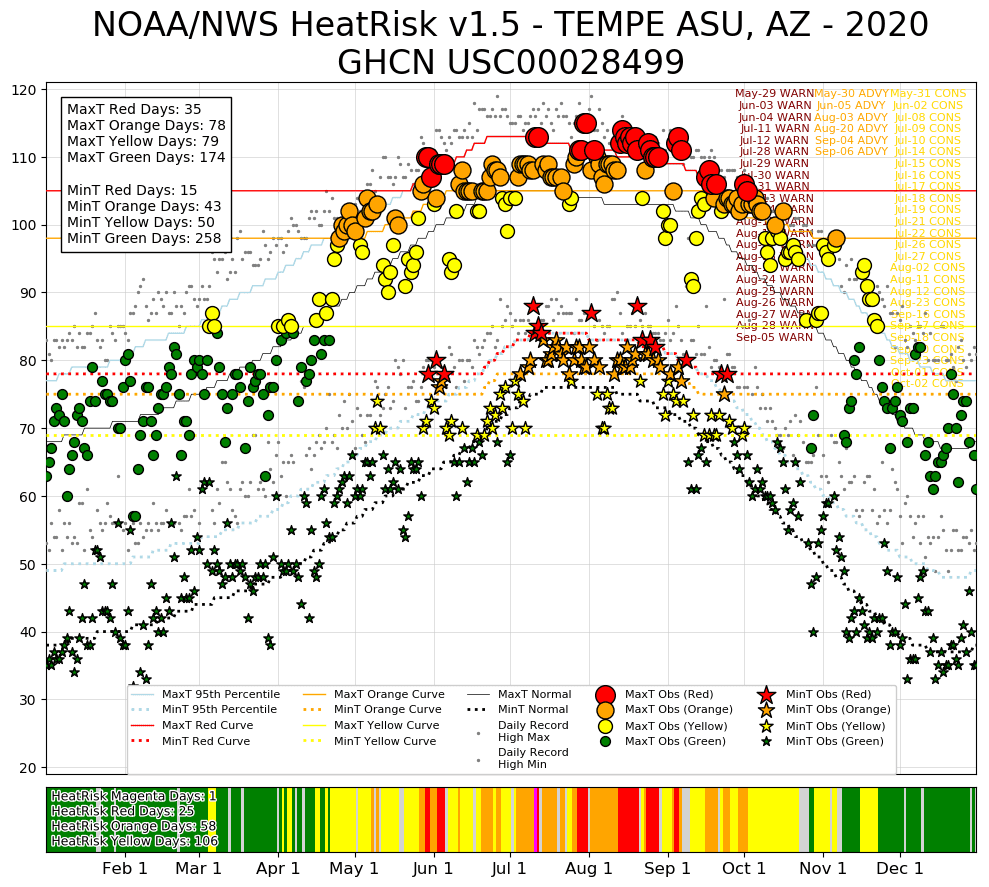 Heat is the number one weather-related killer in Arizona.
Heat is the number one weather-related killer in Arizona.
Weather-related fatality and injury statistics for the United States show that heat causes more fatalities per year than floods, lightning, tornadoes, or hurricanes. Based on the 10-year average from 2011 to 2020, excessive heat claimed (on average) 107 lives each year; floods caused 94 fatalities (average); tornadoes caused 94 fatalities (average); lightning caused 24 fatalities (average); and hurricanes caused 8 fatalities (average).
Learn more about Heat Risk in Arizona.
Access to historical heat data in Arizona.
Current weather conditions and outlooks in Arizona.
National Weather Hazards
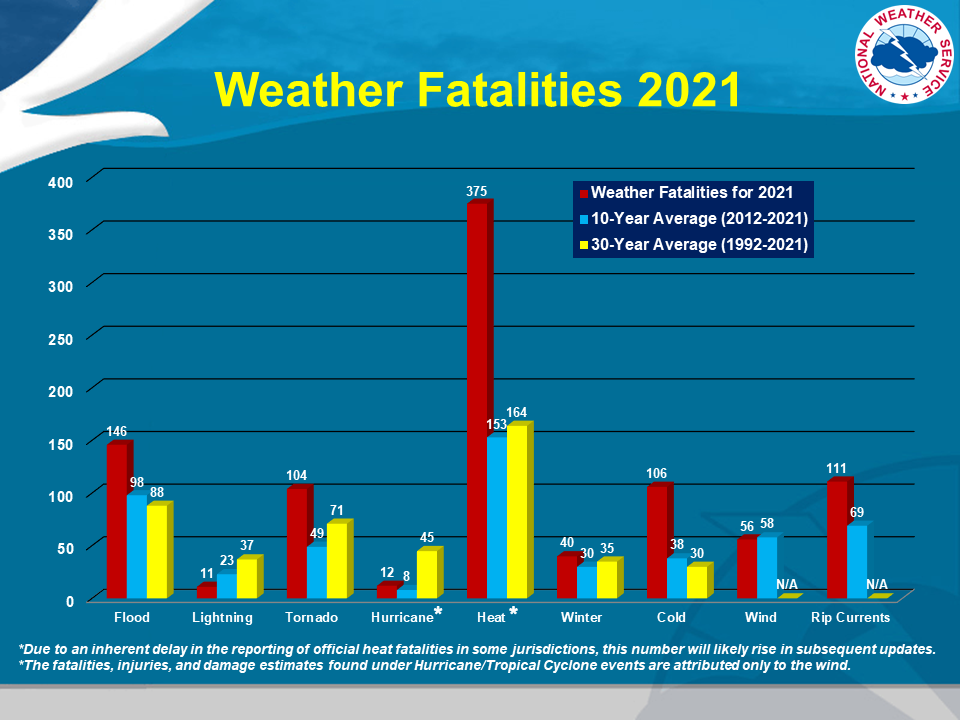
In the deadly Kansas City heat wave of 1980, more than 1,250 people lost their lives from heat-related illnesses. In the Chicago heat wave of 1995 more than 700 deaths in the Chicago, Illinois area were attributed to this event, and in August 2003, a record heat wave in Europe claimed more than 20,000 lives.
North American summers are hot; most summers see heat waves in one section or another of the United States. East of the Rockies, conditions tend to combine both high temperature and high humidity, although some of the worst events have been catastrophically dry.
The U.S. Natural Hazard Statistics provide statistical information on fatalities, injuries and damages caused by weather related hazards. These statistics are compiled by the Office of Services and the National Climatic Data Center from information contained in Storm Data, a report comprising data from NWS forecast offices in the 50 states, Puerto Rico, Guam and the Virgin Islands.
Arizona Weather Hazards
Extreme Heat
 Excessive heat is one of the most deadly weather conditions on record. The weather may seem calm outside despite the extreme air temperature, but these are not conditions to be taken lightly. Here are some things you can do to prevent heat exhaustion and an unhealthy exposure to the sun’s ultraviolet (UV) rays when you are outdoors:
Excessive heat is one of the most deadly weather conditions on record. The weather may seem calm outside despite the extreme air temperature, but these are not conditions to be taken lightly. Here are some things you can do to prevent heat exhaustion and an unhealthy exposure to the sun’s ultraviolet (UV) rays when you are outdoors:
- Review the forecast for heat Select heat forecasts.
- Drink plenty of water or other beverages that do not contain caffeine, large amounts of sugar, or alcohol.
- Wear sunscreen, sunglasses, and light-colored, light-fitted clothing.
- Take breaks from your activities if they are strenuous.
- If you experience light-headedness, headaches, cramps, or other disorienting symptoms, find a cooler location and rest until symptoms recede. Remember to hydrate frequently, but not in large quantities.
- Pay careful attention to young children and elderly people who are outside in the heat for they are the most vulnerable to these heat symptoms. For more details, click on the following link: https://www.weather.gov/bgm/heat
- For more information on weather hazards and health in Arizona, click on the following link: https://www.azdhs.gov/preparedness/epidemiology-disease-control/extreme-weather/heat-safety/index.php#heat-home
Lightning
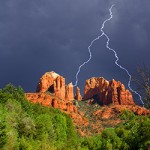 Lightning storms can be a spectacular event; however, it is important to protect yourself from lightening strikes. Here are some safety tips:If you hear thunder within 30 seconds of a lightning strike, it is time to head indoors. If you are not at home, take refuge in the nearest public facility. If you are in a vehicle, remain in your vehicle until the storm passes. Make sure to avoid touching anything metal in the vehicle since electricity from lightning can travel through those objects.
Lightning storms can be a spectacular event; however, it is important to protect yourself from lightening strikes. Here are some safety tips:If you hear thunder within 30 seconds of a lightning strike, it is time to head indoors. If you are not at home, take refuge in the nearest public facility. If you are in a vehicle, remain in your vehicle until the storm passes. Make sure to avoid touching anything metal in the vehicle since electricity from lightning can travel through those objects.
When indoors, do not use telephones, water faucets, or any electronic devices. Unplug all power cords from electrical sockets in the walls since lightning can travel through these cables as a medium conductor. Lightning can also travel through windows, so please keep a safe distance from them until the storm calms or passes.
For more information on lightning safety and other resources, click on the following link: https://www.weather.gov/safety/lightning
Flash Floods
 Flash floods can occur at anytime and are extremely dangerous due to their quick currents and tall waves. If a flash flood warning has been issued in your area, make your way to higher ground as soon as possible. Do not approach running water such as streams or canals. The water level can rise dramatically within seconds. If you are driving, avoid driving through low streets or dips where the rushing water can take vehicles and their passengers with it. If you need to pass through a flooded area, determine the depth of the water before crossing. Water beds may be unstable or soft and can cause a passing vehicle to become stuck. In the event that your vehicle gets stuck or stalls, abandon your vehicle and get to a higher elevation as quickly as possible.For more information on flash flood safety and other resources, click on the following link: https://www.weather.gov/safety/flood
Flash floods can occur at anytime and are extremely dangerous due to their quick currents and tall waves. If a flash flood warning has been issued in your area, make your way to higher ground as soon as possible. Do not approach running water such as streams or canals. The water level can rise dramatically within seconds. If you are driving, avoid driving through low streets or dips where the rushing water can take vehicles and their passengers with it. If you need to pass through a flooded area, determine the depth of the water before crossing. Water beds may be unstable or soft and can cause a passing vehicle to become stuck. In the event that your vehicle gets stuck or stalls, abandon your vehicle and get to a higher elevation as quickly as possible.For more information on flash flood safety and other resources, click on the following link: https://www.weather.gov/safety/flood
Dust Storms
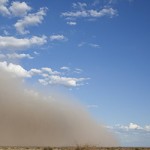 It is extremely hazardous to drive in a dust storm because they can cause little or no visibility for the driver. Here is what to do in the event of a dust storm.
It is extremely hazardous to drive in a dust storm because they can cause little or no visibility for the driver. Here is what to do in the event of a dust storm.
- Do not drive into the dust storm.
- Pull off the roadway and turn off all lights.
- Put on the emergency brake and wait for the storm to pass through.
For a more details, click on the following link: Pull Aside – Stay Alive
Wildfires
 Everyone should make sure to have an evacuation plan in case of wildfires as well as for other natural disasters. Make a list of emergency supplies such as first aid, water, protective clothing, etc. If your area has been told to evacuate, make sure to remove combustible items from the house. Close all windows, doors, or anything that can ventilate air into the house. If you are caught in the wildfire, find a body of water such as a stream to sit in to protect yourself. Breath low to the ground to prevent inhaling smoke.
Everyone should make sure to have an evacuation plan in case of wildfires as well as for other natural disasters. Make a list of emergency supplies such as first aid, water, protective clothing, etc. If your area has been told to evacuate, make sure to remove combustible items from the house. Close all windows, doors, or anything that can ventilate air into the house. If you are caught in the wildfire, find a body of water such as a stream to sit in to protect yourself. Breath low to the ground to prevent inhaling smoke.
Source: http://environment.nationalgeographic.com/environment/natural-disasters/wildfire-safety-tips/#
For more information, click on the link above, or check out the article from ready.gov on wildfires by following this link: http://www.ready.gov/wildfires
Tornadoes
 While Arizona typically has only a handful of tornadoes each year, and they are generally F3 or smaller, they still need to be given the proper respect. If a tornado warning has been issued in your area, find shelter immediately such as a basement or storm shelter. If you are in a building without a designated safety area, head to the lowest level of the building and find a closet or small hallway closest to the center of the building layout. Avoid corners, doors, and windows. Cover yourself with blankets and/or coats to shield you from flying debris. Wearing a helmet during a tornado warning is also advised. If you are in a vehicle, drive to the nearest building and seek refuge there. If there are no buildings near you, stay in your vehicle with your head below the windows. Make sure to cover yourself with whatever you can find. If there is a ditch or an area of lower ground near you, leave your vehicle and lie there. Be sure to protect your head with your arms and hands.
While Arizona typically has only a handful of tornadoes each year, and they are generally F3 or smaller, they still need to be given the proper respect. If a tornado warning has been issued in your area, find shelter immediately such as a basement or storm shelter. If you are in a building without a designated safety area, head to the lowest level of the building and find a closet or small hallway closest to the center of the building layout. Avoid corners, doors, and windows. Cover yourself with blankets and/or coats to shield you from flying debris. Wearing a helmet during a tornado warning is also advised. If you are in a vehicle, drive to the nearest building and seek refuge there. If there are no buildings near you, stay in your vehicle with your head below the windows. Make sure to cover yourself with whatever you can find. If there is a ditch or an area of lower ground near you, leave your vehicle and lie there. Be sure to protect your head with your arms and hands.
Source: http://environment.nationalgeographic.com/environment/natural-disasters/tornado-safety-tips/
For more information on what to do before and after a tornado warning, follow the link provided: http://www.ready.gov/tornadoes
For information on Tornado Frequency by month in the U.S. visit:
Winter Storms
 Despite Arizona’s reputation for having a dry heat, locations north of the Mogollon Rim have experienced winter storms. Winter storms typically range from measurable snowfall to hours of blizzard-like conditions that create low visibility and are powered by strong winds. Remain indoors if possible. Put together a safety/supply kit with things like first aid kits, food, water, flashlights, batteries, warm clothing, etc. For a more detailed list, go to http://www.redcross.org/prepare/disaster/winter-storm. If you need to utilize a vehicle, make sure to equip snow chains to the tires and keep the fuel tank full to prevent it from freezing. Indoor thermostats should be kept at no less than 55 degrees F.
Despite Arizona’s reputation for having a dry heat, locations north of the Mogollon Rim have experienced winter storms. Winter storms typically range from measurable snowfall to hours of blizzard-like conditions that create low visibility and are powered by strong winds. Remain indoors if possible. Put together a safety/supply kit with things like first aid kits, food, water, flashlights, batteries, warm clothing, etc. For a more detailed list, go to http://www.redcross.org/prepare/disaster/winter-storm. If you need to utilize a vehicle, make sure to equip snow chains to the tires and keep the fuel tank full to prevent it from freezing. Indoor thermostats should be kept at no less than 55 degrees F.
To learn more about staying safe in a winter storm, go to any of these sources:
Hail
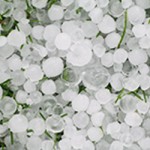 Hail can be a very serious problem holding the potential to damage property and cause harm to anybody in the fray. Hailstorms do not last long with an average duration of 6 minutes. If you are outside when hail starts to fall, take shelter immediately. Protect your head when in the hailstorm. If you are indoors, stay away from windows and make sure to stay inside until the hailstorm and the weather outside calms. If you are driving when a hailstorm occurs, find someplace to park under to protect your vehicle from falling hail. If such a place is not accessible at the time, find a safe place to pull over. Lie down in the vehicle to keep away from the windows where large hail may penetrate.
Hail can be a very serious problem holding the potential to damage property and cause harm to anybody in the fray. Hailstorms do not last long with an average duration of 6 minutes. If you are outside when hail starts to fall, take shelter immediately. Protect your head when in the hailstorm. If you are indoors, stay away from windows and make sure to stay inside until the hailstorm and the weather outside calms. If you are driving when a hailstorm occurs, find someplace to park under to protect your vehicle from falling hail. If such a place is not accessible at the time, find a safe place to pull over. Lie down in the vehicle to keep away from the windows where large hail may penetrate.
For more information on safety from hail, check out these resources:
Driving in hail: http://www.progressive.com/vehicle-resources/hail-driving/
Staying Safe during a Hail Storm
For facts and statistics on Hail, visit:
For more information on weather safety, check out these resources:
Weather Safety: https://www.weather.gov/safety/
Severe Weather Safety Tips: https://www.weather.gov/safety/
